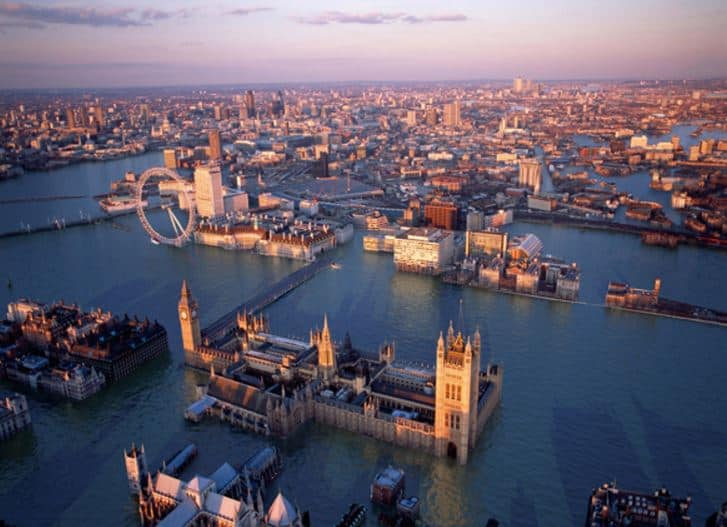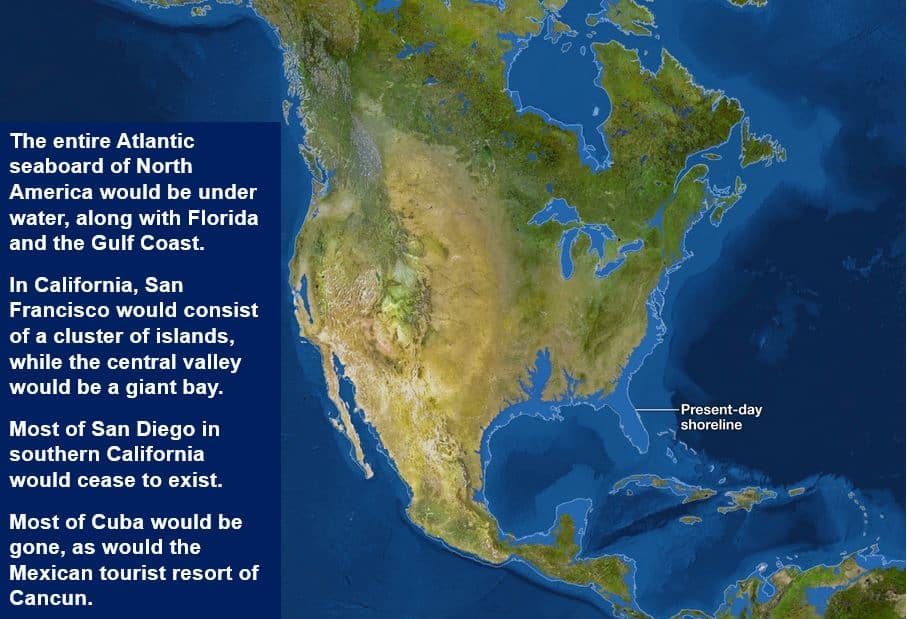The sea level and temperature rises caused by climate change are here to stay for the next several thousand years, in fact, at least ten thousand years into the future, says an international team of scientists from the USA, UK, Canada, Germany, Switzerland, France and Australia.
All climate change models that look one or two centuries into the future show a rapid increase in sea levels and temperatures, but most of them say nothing about our longer-term prospects
In this study, which has been published in the prestigious scientific journal Nature Climate Change, data suggests that the catastrophic impact of another three hundred years of carbon pollution will persist for thousands of years after the CO2 (carbon dioxide) releases stop.
 How would Londoners cope? What would be the city’s future if this persisted, and even worsened over a period of thousands of years? (Image: london-futures.com)
How would Londoners cope? What would be the city’s future if this persisted, and even worsened over a period of thousands of years? (Image: london-futures.com)
It is a chilling picture, says co-author Shaun Marcot, Assistant Professor of Paleoclimate and Glacial Geology at the University of Wisconsin-Madison’s Department of Geoscience, USA, with a virtually inevitable rise in sea levels for thousands of years into the future.
The majority of climate forecasts today end at the year 2300 at the latest, says Prof. Marcott “because that’s the time period most people are interested in.”
This study looks 10,000 years into the future
Prof. Marcott added:
“Our idea was that this did not encapsulate the entire effect of adding one to five trillion tons of carbon dioxide to the atmosphere over the next three centuries.”
“Whereas most studies look to the last 150 years of instrumental data and compare it to projections for the next few centuries, we looked back 20,000 years using recently collected carbon dioxide, global temperature and sea level data spanning the last ice age.”
“Then we compared past data to modeling results that extend 10,000 years into the future.”
Earth’s climate – the interplay among atmosphere, land and ocean – has a long memory, Marcott explains.
 This is what North America would look like if all the ice in the poles melted. If the situation is going to linger, and even worsen for thousands of years, regardless of what we do now, wouldn’t it be better if we focussed on adapting, rather than trying to stop the global warming (which clearly we can’t)? (Image: National Geographic)
This is what North America would look like if all the ice in the poles melted. If the situation is going to linger, and even worsen for thousands of years, regardless of what we do now, wouldn’t it be better if we focussed on adapting, rather than trying to stop the global warming (which clearly we can’t)? (Image: National Geographic)
Rising temperature and sea level will continue regardless of our actions
Most of us believe that the sea level and temperature rises will continue if we carry on burning fossil fuels, and will cease as soon as we find alternative fuel sources, i.e. as soon as we stop emitting so much CO2 and other greenhouse gases.
This is a false belief. Prof. Marcott says:
“In fact, it will take many thousands of years for the excess carbon dioxide to completely leave the atmosphere and be stored in the ocean, and the effect on temperature and sea level will last equally long.”
In this study, the scientists looked at four levels of carbon pollution that would start in 2000 and cease in 2300. The sophisticated modelling effort was organized by Michael Eby, from the University of Victoria and Simon Fraser University (both in Canada).
Prof. Marcott explained:
“Carbon is going up, and even if we stop what we are doing in the relatively near future, the system will continue to respond because it hasn’t reached an equilibrium. If you boil water and turn off the burner, the water will stay warm because heat remains in it.”
Inertia of climate change has a long reach
What happens in our planet’s climate system is similar to Prof. Marcott’s boiling water example, but is considerably more complex and longer lasting.
New data on the relationship among CO2, temperature and sea level over the past 20,000 years was the basis for looking 10,000 years into the future.
 Perhaps Belgian architect, Vincent Callebaut’s underwater village design should be considered by future governments as a possible way of coping when sea levels rise too high. Most of his villages, which contain skyscrapers, are built below sea level in the oceans. (Image: vincent.callebaut.org)
Perhaps Belgian architect, Vincent Callebaut’s underwater village design should be considered by future governments as a possible way of coping when sea levels rise too high. Most of his villages, which contain skyscrapers, are built below sea level in the oceans. (Image: vincent.callebaut.org)
Prof. Marcott said:
“Now that we know how these factors changed from the Ice Age to today, we thought, if we really want to put the future in perspective, we can’t look out just 300 years. That does not make sense as a unit of geological time.”
Releases today of carbon contained in CO2 total approximately 10 billion tons annually. The figure is growing 2.5% per year, more than twice the rate recorded in the 1990s.
We have already put around 580 billion tons of CO2 into the atmosphere. The scientists looked at the effect of releasing a further 1,280 to 5,120 billion tons over a 300-year period (2000 to 2300).
In their models, the CO2 input ceases after 300 years, but its impact continues for 10,000 years.
Carbon impact continues for astonishingly long time
By the end of the 300-year period, i.e. the year 2300, the CO2 level jumped from nearly 400 parts per million to as much as 2,000 parts per million. In the highest temperature rise scenario – about 7°C – after 10,000 years it would have tapered ever so slightly, just by 1°C to 6°C.
In other words, we would be stuck with an increase of at least 6°C for 10,000 years.
 If all the ice in and around the poles melted, the UK map would look completely different. Everything in organge in this image would be under water. Most of London would be gone, East Anglia would disappear completely, and much of the densely-populated south-east of England would be under water. (Image: coolgeography.co.uk)
If all the ice in and around the poles melted, the UK map would look completely different. Everything in organge in this image would be under water. Most of London would be gone, East Anglia would disappear completely, and much of the densely-populated south-east of England would be under water. (Image: coolgeography.co.uk)
Prof. Marcott said:
“Most people probably expect that temperature and carbon dioxide will rise together and then temperature will come down when the carbon dioxide input is shut off, but carbon dioxide has such a long life in the atmosphere that the effects really depend on how much you put in.”
“We are already committed to substantial rises in temperature. The only question is how much more is in the pipe.”
The warming atmosphere and oceans that are already melting ice sheets and glaciers produce a catastrophic rise in sea levels.
Regarding sea levels, Prof. Marcott said:
“Sea level will go up due to melting, and because warming expands the ocean. We have to decide in the next 100 years whether we want to commit ourselves and our descendants to these larger and more sustained changes.”
One fifth of Earth’s population has bleak future
First author Peter Clark, Professor of Geology and Geophysics at Oregon State University’s College of Earth Ocean and Atmospheric Sciences, and colleagues calculated that ocean encroachment in the lowest carbon-input scenario would affect land that in 2010 housed 19% of Earth’s human population.
However, the effect would continue getting worse for considerably longer – thousands of years.
Jack Williams, a professor of geography and expert on past climates at UW-Madison, who was not involved in the study, said:
“This is a stunning paper. At one level, it just reinforces a point that we already knew: that the effects of climate change and sea level rise are irreversible and going to be with us for thousands of years.”
“But this paper shows just how devastating sea level rise will be, once we look out beyond 2100 A.D.”
In the highest carbon pollution scenario the sea would rise by 80 to 170 feet (24.4 to 51.8 metres). “That’s enough to drown nearly all of Florida and most of the Eastern Seaboard,” said Prof. Williams.
Nelson’s Column in Trafalgar Square, London, is 52 metres high – imagine the world’s seas rising by that amount? What would be left of the UK?
For simplicity, the researchers did not include other major drivers and effects of climate change, such as other greenhouse gases, ocean acidification, and mechanisms that cause the warming to speed up.
Prof. Marcott said:
“It’s worrisome, for sure. I don’t see any good thing in this, but my hope is that you could show these graphs to anyone and they could see exactly what is going on.”
Prof. Marcott commented on a recent slogan of climate campaigners – ‘Keep it in the ground’ – describing it as ‘apt’. “In the ideal situation, that is what would happen, but I can’t say if it is economically or politically viable,” he said.
Prof. Williams added:
“The paper emphasizes that we need to move to net-zero or net-negative carbon emissions and have only a few more decades to do so. But the real punch in the gut is the modeled sea level rise and its implications.”
In an Abstract in the journal, the authors concluded:
“This long-term perspective illustrates that policy decisions made in the next few years to decades will have profound impacts on global climate, ecosystems and human societies — not just for this century, but for the next ten millennia and beyond.”
Citation: “Consequences of twenty-first-century policy for multi-millennial climate and sea-level change,” Peter U. Clark, Gian-Kasper Plattner, Jeremy D. Shakun, Shaun A. Marcott, Raymond T. Pierrehumbert, Alan C. Mix, Michael Eby, Scott Kulp, Anders Levermann, Kurt Lambeck, Glenn A. Milne, Patrik L. Pfister, Aaron Goldner, Benjamin D. Santer, Daniel P. Schrag, Edouard Bard, Susan Solomon, Thomas F. Stocker, David Archer, Benjamin H. Strauss, Ricarda Winkelmann and Andrew J. Weaver. Nature Climate Change. 8 February 2016. DOI: 10.1038/nclimate2923.
Video – Future Sea Level Rise
This video looks at would happen to 10 countries if sea levels rose by just 6 metres.
